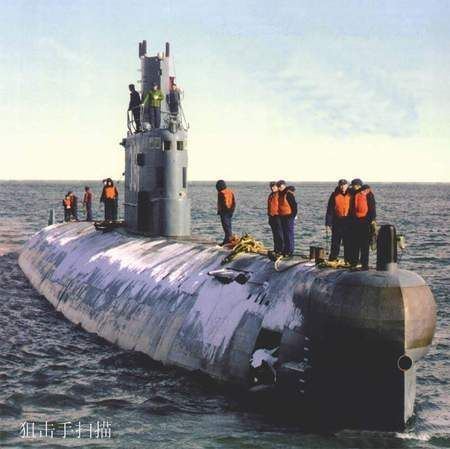Name No. 361 Beam 7.6 m (24 ft 11 in) Length 76 m | Draft 5.1 m (16 ft 9 in) | |
 | ||
Propulsion 2 × Shaanxi 6E 390 ZC1 diesels rated at 5,200 hp (3.82 MW)2 × Xiangtan alternators2 shafts | ||
The submarine hull number No. 361 with name Great Wall #61 (长城61号) is a Chinese People's Liberation Army Navy Type-035AIP (ES5E variant) (NATO reporting name Ming III) conventional diesel/electric submarine. In 2003 while at the Bohai Sea between North Korea and China's Shandong Province, the vessel suffered a systems failure that killed all 70 crew members on board.
Contents
No. 361 was part of the 12th Brigade of the North Sea Fleet of the PLAN based at Lüshunkou (formerly Port Arthur) in Liaoning Province.
Ming class
The Ming class of Chinese submarines are an adaptation of the diesel/electric Romeo class submarine built in the Soviet Union, which are based on the German Type XXI submarine of World War II.
The Central Military Commission ordered the building of the Ming class submarines in 1967 as Project 035. The construction of the first began during October, 1969 at Wuhan Shipyard. The last boat was built in 2002. A total of 20 boats were built, of which 17 are left, and most serve in the North Sea Fleet. No. 361 serving the East Sea Fleet was the thirteenth and was built in 1995 making it one of the newest in the fleet.
CNN reports that China is increasing training and exercises of its submarines in the east to carry out a policy of "sea denial" to try counter the powerful U.S. Pacific fleet. The location of the incident (see below), the Bohai Sea is very strategic for China. It is the closest sea outlet to Beijing, and one of the busiest sea routes in the world.
Fatal incident
According to the official Chinese news agency, Xinhua, all 70 crew members died when the submarine's diesel engine used up all the oxygen (because it failed to shut down properly) while the boat was submerged on April 16, 2003. The submarine, which was commanded by was Commodore Cheng Fuming (程福明), had been taking part in naval exercises east of Inner Changshan Islands in the Bohai Sea of Northeastern China. Along with its normal compliment, the crew also included 13 trainee cadets from the Chinese naval academy.
After the disaster, the crippled submarine drifted for ten days because it was on a silent, no-contact exercises. The boat was discovered by Chinese fishermen who noticed its periscope sticking above the surface on April 25, 2003. The submarine was initially towed to Yulin Harbor near Sanya on Hainan Island before being taken back to the northeast seaport of Dalian in Liaoning province in Northeast China.
Impact
CMC Vice-chairman Guo Boxiong led an enquiry into the incident, which resulted in the dismissal of four senior PLAN officers on June 13, 2003. Four other senior officers were also demoted. The official verdict was improper "command and control".
